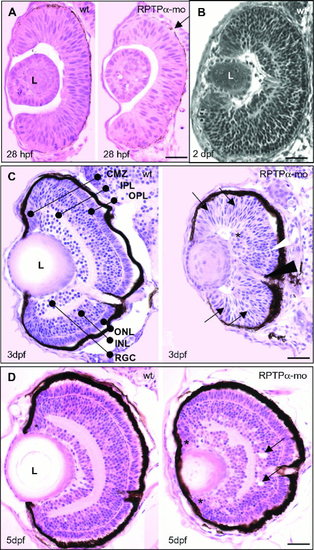
Receptor protein-tyrosine phosphatase alpha (RPTPα) knock-down?induced defects in eye development. Retinal organization of wild-type (left panels) and RPTPα-morpholino (-mo) -injected embryos (right panels). Transverse median sections through the eye of embryos at different developmental stages. A: At 28 hours postfertilization (hpf), the neural retina of RPTPα-mo?injected embryos consists of fewer cells compared with wild-type (wt) retinae. The arrow indicates the pigmented neural epithelium. B: Transverse section of a 2-days postfertilization (dpf) -old embryo. The retina already shows lamellar organization (see also: http://imaging.niob.knaw.nl/). C: At 3 dpf, the neural retina of RPTPα-mo?injected embryos are largely undifferentiated (arrows) and only in the central region some rudimentary lamellar organization can be observed. Overall, the size of the eye is reduced compared with wild-type embryos. The asterisk indicates potential retinal ganglion cells, the white arrowhead indicates potential outer plexiform layer, and the black arrowhead indicates the optic nerve. D: At 5 dpf, the retinae of RPTPα-mo?injected embryos contain five layers and most cells are differentiated. Asterisks indicate the ciliary marginal zones, arrows indicate gaps in the amacrine cell layer of the inner nuclear cell layer. At least three embryos were examined per stage, and representative sections are depicted here. L, lens; CMZ, ciliary marginal zone; RGC, retinal ganglion cells; IPL, inner plexiform layer; INL inner nuclear layer; OPL, outer plexiform layer; ONL, outer nuclear layer. Scale bars = 50 μm in A,C,D, 60 μm in B.
|

